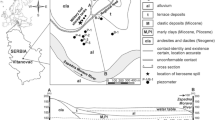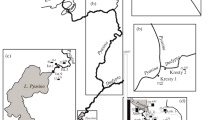Abstract
Leakage of jet fuel from an oil skimmer has resulted in soil and groundwater contamination at the fire fighting training site of the Oslo international airport. The site is located on an unconfined sandy aquifer formed by the Gardermoen ice contact delta. A strong relationship between hydrogeological settings and spatial distribution of the hydrocarbons has been observed. Leaching hydrocarbons constitute a source of dissolved BTEX and naphthalene. Concentration of the dissolved hydrocarbons, electron acceptors and metabolic by-products has revealed concomitant changes in space and in time, in response to groundwater fluctuations. Correlation between high concentrations of hydrocarbons, elevated alkalinity and depleted electron acceptors supports the hypothesis that intrinsic bioremediation has been taking place at the site. Naphthalene, however, has been found persistent under anoxic conditions. Calculations of biodegradation potential indicates that Fe(III) reduction, methanogenesis, nitrate and sulphate reduction are the main factors controlling biodegradation.












Similar content being viewed by others
References
Aagaard, P., Breedveld, G., Rudolph-Lund, K., Zheng, Z. & Kłonowski, M. R. (2001). Natural attenuation of jet fuels contaminated sediments and groundwater at the fire fighting training place of the international airport Gardermoen (in Norwegian). Paper presented at the 10th Seminar on Hydrogeology and Environmental Geochemistry, Trondheim.
Alfnes, E., Breedveld, G. D., Kinzelbach, W. & Aagaard, P. (2003a). Investigation of hydrogeologic processes in a dipping layer structure. 2. Transport and biodegradation of organics. Journal of Contaminant Hydrology, DOI 10.1016/j.jconhyd.2003.08.006
Alfnes, E., Kinzelbach, W. & Aagaard, P. (2003b). Investigation of hydrogeologic processes in a dipping layer structure: 1. The flow barrier effect. Journal of Contaminant Hydrology, DOI 10.1016/j.jconhyd.2003.08.003
Andersson, A. C., Andersson, O. & Gustafson, G. (1984). Wells, Exploration-Dimensioning-Drilling-Use. Report R42 (in Swedish). Stokholm: Byggforskningsradet.
Appelo, C. A. J. & Postma, D. (1996). Geochemistry, groundwater and pollution. Rotterdam: A.A.Balkema.
Barker, J. F., Patric, G. C. & Major, D. (1987). Natural attenuation of aromatic hydrocarbons in a shallow sand aquifer. Groundwater Monitoring Review, 64–71, Winter.
Basberg, L., Dagestad, A. & Engesgaard, P. (1998). Geochemical modelling of natural geo-/hydrochemical stratification dominated by pyrite oxidation and calcite dissolution in a glaciofluvial Quaternary deposit, Gardermoen, Norway. NGU bulettine, 434, 10.
Baun, A., Reitzel, L. A., Ledin, A., Christensen, T. H. & Bjerg, P. L. (2003). Natural attenuation of xenobiotic organic compounds in a landfill leachate plume (Vejen, Denmark). Journal of Contaminant Hydrology, 65, 269–291.
Bekins, B. A., Cozzarelli, I. M., Godsy, E. M., Ean, W., Essaid, H. I. & Tucillo, M. E. (2001). Progression of natural attenuation processes at a crude oil spill site: II. Controls on spatial distribution of microbial populations. Journal of Contaminant Hydrology, 53, 387–406.
Bennett, P. C., Siegel, D. E., Baedecker, M. J. & Hult, M. F. (1993). Crude oil in a shallow sand and gravel aquifer – I. Hydrogeology and inorganic geochemistry. Applied Geochemistry, 8, 529–549.
Bjerg, P. L., Rugge, K., Cortsen, J., Nielsen, P. H. & Christensen, T. H. (1999). Degradation of aromatic and chlorinated aliphatic hydrocarbons in the anaerobic part of the Grindsted Landfill leachate plume: in situ microcosm and laboratory batch experiments. Ground Water, 37, 113–121.
Borden, R. C., Daniel, R. A., LeBrun IV, L. & Davis, C. W. (1997). Intrinsic biodegradation of MTBE and BTEX in a gasoline-contaminated aquifer. Water Resources Research, 33, 1105–1115.
Chapelle, F. H. (2000). The significance of microbial processes in hydrogeology and geochemistry. Hydrogeology Journal, 8, 41–46.
Chapelle, F. H. (2001). Ground-Water Microbiology and Geochemistry. New York, USA: Wiley.
Chapelle, F. H., McMahon, P. B., Dubrovsky, N. M., Fujii, R., Oaksford, E. T. & Vroblesky, D. A. (1995). Deducing the distribution of terminal electron-accepting processes in hydrologically diverse groundwater systems. Water Resources Research, 31, 359–371.
Cheol-Hyo, L., Jin-Yong, L., Jeong-Yong, C. & Kang-Kun, L. (2001). Attenuation of petroleum hydrocarbons in smear zones: a case study. Journal of Environmental Engineering, 639–647, July.
Chiang, C. Y., Salanitro, J. P., Chai, E. Y., Colthart, J. D. & Klein, C. L. (1989). Aerobic biodegradation of benzene, toluene, and xylene in a sandy aquifer-data analysis and computer modeling. Ground Water, 27, 823–834.
Christensen, T. H., Bjerg, P. L., Banwart, S. A., Jakobsen, R., Heron, G. & Albrechtsen, H.-J. (2000a). Characterization of redox conditions in groundwater contaminant plumes. Journal of Contaminant Hydrology, 45, 165–241.
Christensen, T. H., Bjerg, P. L. & Kjeldsen, P. (2000b). Natural attenuation: a feasible approach to remediation of groundwater pollution at landfills? Groundwater Monitoring and Remediation, 69–77, Winter.
Council, N. R. (1994). Alternatives for groundwater cleanup. Washington: National Academy Press.
Cozzarelli, I. M., Bekins, B. A., Baedecker, M. J., Aiken, G. R., Eganhouse, R. P. & Tucillo, M. E. (2001). Progression of natural attenuation processes at a crude-oil spill site: I. Geochemical evolution of the plume. Journal of Contaminant Hydrology, 53, 369–385.
Dagestad, A. (1998). In situ airsparging as a remedial action at the Gardermoen aquifer, Southeast Norway (in Norwegian). Dissertation, Norwegian University of Science and Technology.
Davis, G. B., Barber, C., Power, T. R., Thierrin, J., Petterson, B. M., Rayner, J. L. & Wu, Q. (1999). The variability and intrinsic remediation of a BTEX plume in anaerobic sulphate-rich groundwater. Journal of Contaminant Hydrology, 36, 265–290.
Eganhouse, R. P., Baedecker, M. J., Cozzarelli, I. M., Aiken, G. R., Thorn, K. A. & Dorsey, T. F. (1993). Crude oil in a shallow sand and gravel aquifer-II. Organic geochemistry. Applied Geochemistry, 8, 551–567
Fetter, C. W. (1992). Contaminant Hydrogeology. London: Prentice Hall.
Fetter, C. W. (2001). Applied Hydrogeology. London: Prentice Hall.
Fitts, C. R. (2002). Groundwater Science. Amsterdam: Academic.
French, H. K. (1999). Transport and degradation of deicing chemicals in a heterogenous unsaturated soil. Dissertation, Agricultural University of Norway.
Golden Software, I. (2002). Surfer 8. User’s Guide. Contouring and 3D Surface Mapping for Scientists and Engineers. Golden: Golden Software.
Grbic-Galic, D. (Eds.) (1991). Anaerobic microbial degradation of aromatic hydrocarbons. Amsterdam: Elsevier.
Haack, S. K. & Bekins, B. A. (2000). Microbial populations in contaminant plumes. Hydrogeology Journal, 8, 63–76
Joergensen, P. & Oestmo, S. R. (1992). Research Programme. The Environment of the Subsurface. Part I: The Gardermoen Project, 1992–1994. Introductory Report. Literature Review and Project catalogue. Hydrogeology at Romerike.
Klecka, G. M., Davis, J. W., Gray, D. R. & Madsen, S. S. (1990). Natural bioremediation of organic contaminants in ground water: Cliffs-Dow Superfund site. Ground Water, 28, 534–543.
Kłonowski, M. R., Zheng, Z., Aagaard, P., Breedveld, G. D. & Rudolph-Lund, K. (2002). Persistence of Naphthalenein a Jet Fuel contaminated Aquifer. Paper presented at European Conference on Natural Attenuation, Heidelberg.
Kłonowski, M. R., Bredveld, G. D. & Aagaard, P. (2005). Natural gradient experiment on transport of jet fuel derived hydrocarbons in an unconfined sandy aquifer. Environmental Geology, 48, 1040–1057. DOI 10.1007/s00254-005-0042-y
Knudsen, J. B. S. (2003). Reactive transport of dissolved aromatic compounds under oxygen limiting conditions in sandy aquifer sediments. Dissertation, University of Oslo.
Lee, J.-Y., Cheon, J.-Y., Lee, K.-K., Lee, S.-Y. & Lee, M.-H. (2001). Factors affecting the distribution of hydrocarbon contaminants and hydrogeochemical parameters in a shallow sand aquifer. Journal of Contaminant Hydrology, 50, 139–158.
Löser, C., Seidel, H., Zehnsdorf, A. & Stottmeister, U. (1998). Microbial degradation of hydrocarbons in soil during aerobic/anaerobic changes and under purely aerobic conditions. Applied Microbiology and Biotechnology, 49, 631–636.
Lovley, D. R., Chapelle, F. H. & Woodward, J. C. (1994). Use of dissolved H2 concentrations to determine distribution of microbially catalyzed redox reactions in anoxic groundwater. Environmental Science & Technology, 28, 1205–1210.
McAllister, P. M. & Chiang, C. Y. (1994). A practical approach to evaluating natural attenuation of contaminants in ground water. Ground Water Monitoring Review, 161–173, Spring.
Oestmo, S. R. (1976). Hydrogeological Map of Ovre Romerike; groundwater in loose sediments between Jessheim and Hurdalsjone-scale. 1:20 000: Oslo, Norwegian Geological Survey.
Phelps, C. D. & Young, L. Y. (1999). Anaerobic biodegradation of BTEX and gasoline in various aquatic sediments. Biodegradation, 10, 15–25.
Ramm, M. (1991). On quantitative mineral analysis of sandstones using XRD. University of Oslo Department of Geology.
Röling, W. F. M. & Verseveld van, H. W. (2002). Natural attenuation: What does the subsurface have in store? Biodegradation, 13, 53–64.
Rudolph-Lund, K. & Sparrevik, M. (1999a). Mapping of contamination spreading at the fire fighting training place of the Gardermoen international airport (in Norwegian). Norwegian Geotechnical Institute.
Rudolph-Lund, K. & Sparrevik, M. (1999b). A strategy of natural attenuation at the fire fighting training place (in Norwegian). Norwegian Geotechnical Institute.
Sabir, I. H. (2001). Transport of a de-icing chemical and synthetic DNA tracers in groundwater at Oslo Airport, Gardermoen. Field experiments and numerical modelling. Dissertation, Agricultural University of Norway.
Salanitro, J. P. (1993). The role of bioattenuation in the management of aromatic hydrocarbon plumes in aquifers. Groundwater Monitoring and Remediation, 150–161, Fall.
Schirmer, M. & Barker, J. F. (1998). A study of long-term MTBE attenuation in the Borden aquifer, Ontario, Canda. Groundwater Monitoring and Remediation, 113–122, 1998.
Schirmer, M., Butler, B. J., Barker, J. F., Church, C. D. & Schirmer, K. (1999). Evaluation of biodegradation and dispersion as natural attenuation processes of MTBE and benzene at the Borden Field. Physical, Chemical & Earth Sciences, 24, 557–560.
Schlegel, H. G. (1992). Allgemeine Mikrobiologie (in German). Stuttgart, Germany: Georg Thieme Verlag.
Soerensen, R. (1979). Late Weichselian deglaciation in the Oslofjord area, south Norway. Boreas, 8, 241–246.
Soevik, A. K. & Aagaard, P. (2003). Spatial variability of a solid porous framework with regard to chemical and physical properties. Geoderma, 113, 47–76.
Soevik, A. K., Alfnes, E., Breedveld, G. D., French, H., Pedersen, T. S. & Aagaard, P. (2002). Transport and Degradation of toluene and o-xylene in an unsaturated soil with dipping sedimentary layers. Journal of Environmental Quality, 31, 1809–1823.
Stumm, W. & Morgan, J. J. (1996). Aquatic Chemistry. An Introduction Emphasizing Equilibria in Natural Waters. New York: Wiley.
Thomas, J. M., Wilson, J. T. & Ward, C. H. (Eds.) (1997). Microbial processes in the subsurface. Chelsea: Ann Arbor.
Tucker, M. (1988). Techniques in Sedimentology. Oxford: Blackwell Scientific.
Tuttle, K. J., Ostmo, S. R. & Andersen, B. G. (1997). Quantitative study of the distributory braidplain of the Preboreal ice-contact Gardermoen delta complex, southeastern Norway. Boreas, 26, 141–156.
USEPA (1997). Use of Monitored Natural Attenuation at Superfund, RCRA Corrective Action, and Underground Storage Tank Sites. Directive 9200.4–17. US Environmental Protection Agency.
Vroblesky, D. A. & Chapelle, F. H. (1994). Temporal and spatial changes of terminal electron-accepting processes in a petroleum hydrocarbon-contaminated aquifer and the significance for contaminant biodegradation. Water Resources Research, 30, 1561–1570
Ward, C. H., Cherry, J. A. & Scalf, M. R. (Eds.) (1997). Subsurface Restoration. Chelsea: Ann Arbor.
Wiedemeier, T. H., Rifai, H. S., Newell, C. J. & Wilson, J. T. (1999). Natural Attenuation of Fuels and Chlorinated Solvents in the Subsurface. New York: Wiley.
Zheng, Z., Bredveld, G. D. & Aagaard, P. (2001). Biodegradation of soluble aromatic compounds of jet fuel under anearobic conditions: laboratory batch experiments. Applied Microbiology and Biotechnology, 57, 572–578.
Acknowledgements
The first author is deeply grateful to the management and colleagues of the Polish Geological Institute for granting a long study leave in order to complete this research. We all would like to thank Alf Nielsen, Jana Mahačkova, Mufak Naoroz, Kim Rudolf-Lund, Rebecca Worsley and Zouping Zheng for their great help in conducting the field work. Also contribution of Berit Løken Berg, Mufak Naoroz, Turid Winje and Øyvind Kvalvåg to completion of the laboratory analyses is acknowledged. Assistance of the employees of the Gardermoen Airport – Jarl Øvstedal, Stig Moen and Knut Ringheim is acknowledged. The first author would like to thank especially the Donald Kuennen Foundation (the Netherlands) which provided the grants for the scientific books and software.
Author information
Authors and Affiliations
Corresponding author
Rights and permissions
About this article
Cite this article
Kłonowski, M.R., Breedveld, G.D. & Aagaard, P. Spatial and Temporal Changes of Jet Fuel Contamination in an Unconfined Sandy Aquifer. Water Air Soil Pollut 188, 9–30 (2008). https://doi.org/10.1007/s11270-007-9492-z
Received:
Accepted:
Published:
Issue Date:
DOI: https://doi.org/10.1007/s11270-007-9492-z




